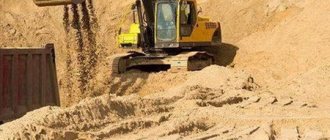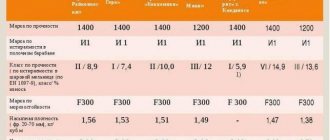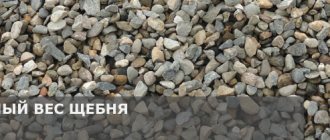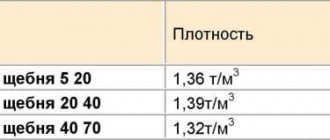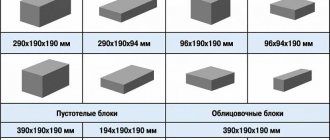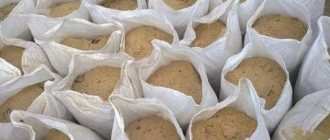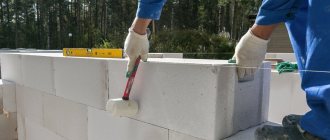How to accurately calculate the required amount of sand
In order to accurately convert cubes of sand into tons or tons into cubes, it is necessary to know exactly the density of this material, provided that it is relatively stable in compaction and a given volume.
Accurate determination of the physical characteristics of sand is possible only in a laboratory; moreover, the humidity and compaction of sand constantly fluctuates depending on weather conditions and the method of its development, so an accurate mathematical calculation is practically impossible. At the same time, the high cost of laboratory research is unprofitable in relation to the error of averaged calculations. That is why in construction it is customary to carry out average calculations with a sand density of 1600 kg/m3 at a humidity of 5-7%. More than converting tons of sand into cubes, the problem is determining a sufficient amount of material, taking into account its compaction, because during the development, transportation and storage the volume of sand changes significantly. Therefore, when purchasing, a coefficient of 1.1-1.27 is usually introduced, taking into account these features, i.e. if according to calculations you need 10 m3, then it costs 11-13 m3, depending on the intended purpose of the material and the method of its storage.
If you want the real density of sand, taking into account weather and transport conditions, just call us at (343) 372-15-80 (81,82,83), and our managers will carry out all the necessary calculations for you.
| Why is the volumetric weight of different types of crushed stone different? |
| Calculation of the volume and weight of crushed stone/sand in the machine |
Production
The most expensive delivery method is road transport, but it is also the most efficient.
Ordering one large car is cheaper than two small ones. A full-flowing river not only cleanses the mineral from silt, clay, organic matter, and other light impurities. Moving water also sorts it naturally, qualitatively separating the fractions. Final cleaning is carried out during the extraction process, consisting of the following stages:
- Actually, lifting from the bottom is carried out using a “dredger” - a technical vessel. It can be equipped with a “scooper” (for compacted sand) and (or) a powerful pump (silt sucker) with a large diameter hose.
- The semi-liquid mixture is unloaded onto a cargo receiving barge equipped with devices for discharging water, or directly onto the shore (shore structures).
- Here the sand mass is washed as many times as required by the technical process, based on the characteristics of the deposit. As a rule, the product from the bottom of the river does not require very complex technical procedures for purification and enrichment.
- Then it is dried, creating special conditions or simply storing it in the open air.
- Then, from one or more mined batches, depending on the regulations, samples are taken for laboratory analysis and testing.
- Only now the river is transported to the storage site, further processing (processing) or to the customer.
The product is transported by barges, railway dump trucks or vehicles. In the first case, the landing stage is often skipped, which reduces the price of the material. However, transportation by water does not contribute to compaction, which means that the volume is obviously overestimated.
Why know how many cubes are in a ton of sand - specific gravity
Almost all building materials are either artificial or natural. Speaking about the last option, it consists of grains with a size of 0.16-5 mm, and its bulk density is in the range of 1300-1500 kn/m3.
Whatever type of sand you choose, you need to know that it has one very good property - it absorbs moisture, removing it from other finished products, while increasing its flowability. It is logical that if the volume changes, then the bulk density itself changes, which in turn depends on how the humidity changes.
If, for example, humidity fluctuates in the range of 3-10%, then this material differs from dry material in its density. It is worth understanding that a grain of sand, which is covered with a layer of water, increases in volume, and this leads to an increase in the density of the sand.
This suggests that when calculating construction work, it is worth taking this into account (bulk density) and knowing how the density changes as humidity increases. It is the level of sand quality that depends on its density.
The density of different types of sand, such as river, quarry or construction sand, will differ slightly from each other.
This is a very necessary characteristic, especially when it comes to professional construction, since this property affects the strength of the object and, accordingly, its service life.
The density of sand is already a known figure and you don’t need to count it, but in order to calculate the volume of sand in a tone, you need to determine its mass. The calculation is carried out using the formula m=V*p. Obviously, v is the volume of sand, and p is the density.
There are two types of sand density:
- Bulk.
- True.
True and bulk density
This value is influenced by some factors that are worth considering:
- the amount of impurities in the material itself (clay, dust, debris);
- immediate humidity level. A fairly humid factor, it is this that influences the density. If the humidity increases to 10%, then the density of the sand decreases, as different lumps form in it. But in such a situation the volume increases;
- sand particle size. Since sand consists of small grains, to take into account its density, you need to know the fraction of the material;
- You also need to take into account the type of sand, which depends on where the sand is mined.
For more information on determining sand density, watch the video:
Fluid compressibility
Liquid compressibility is the property of liquids to change their volume when pressure changes.
Compressibility is characterized by the volumetric compression ratio
(compressibility)
β P
, which is the relative change in the volume of liquid
V
when the pressure
P
by unit.
The minus sign in the formula indicates that as pressure increases, the volume of liquid decreases.
Units: Pa -1
(Pascal. 1Pa=1N/m2).
The absence of a minus sign in this expression means that an increase in pressure leads to an increase in density.
The reciprocal of the compressibility coefficient, or, in other words, the volumetric compression ratio
, denoted
and is called the bulk modulus of elasticity of the liquid.
Then the previous formula will take the form
.
This expression is called Hooke's law for liquids.
Units of measurement: , , [kGs/cm 2
.
Modulus of elasticity E
depends on temperature and pressure.
Therefore, two elastic moduli are distinguished: adiabatic and isothermal. The first occurs in fast processes without heat exchange. The processes occurring in most hydraulic systems involve heat exchange, so the isothermal modulus of elasticity is more often used. The approximate form of the dependences of
Ef on
P and t
is
presented
in the graphs. All this suggests that liquids do not strictly follow Hooke's law.
Let us give several examples of elastic modulus values.
Mineral oils used in hydraulically driven technological machines at t = 20
o C
have volumetric elastic moduli of
1.35 10 3 ÷ 1.75 10 3 MPa
(a lower value refers to lighter oil), gasoline and kerosene - approximately
1.3·10 3 MPa
, glycerin -
4.4·10 3 MPa
, mercury - on average
3.2·10 3 MPa
.
Effect of impurities and temperature on water weight
From a physics point of view, the specific gravity of the liquid is also important. The amount of the substance of interest that is placed in a volume (in 1 of its units) or, if translated into a scientific term - the mass of a unit of volume - is volumetric density or, to put it differently, specific gravity. This value is measured in kg/m3 or in tons/m3 or gp/cm3.
The table below clearly demonstrates the direct effect of temperature and organic impurities on weight. Thus, one cube of liquid in different states contains unequal specific gravity. The data was taken from the reference book of physical properties and materials.
| Name | Number of tons in 1 cube – weight of 1 m3, t/m3 | Number of kilograms in 1 m3 – mass of 1 m3, kg/m3 | Specific gravity, gp/cm3 |
| Water at room temperature at normal atmospheric pressure, m3 | 1 | 1000 | 1 |
| Hot water at normal atmospheric pressure, m3 | 0,98324 | 983,24 | 0,98324 |
| Sea water, m3 | 1,02 | 1020 | 1,02 |
| Water at 0 °C at normal atmospheric pressure, m3 | 0,999 | 999 | 0.999 |
Now you know the true weight of water in different states and under different conditions. And after some simple calculations, you can convert it into the required units of measurement.
How to determine how much a cube of sand weighs: material characteristics
Many owners of country houses try to calculate the weight of sand in one cube. This indicator is especially relevant for suburban construction, which involves such serious amounts of work as the construction of a building or the arrangement of a yard and local area. How much does 1 cubic meter of sand cost with delivery is one of the burning questions of any person who undertakes independent construction or is concerned about purchasing material for hired workers.
Depending on how many kilograms of sand are in a cube, the main proportions of the concrete mixture will be calculated. This point is very important, since an incorrect calculation will lead to disruption of the technology and serious consequences.
Sand is used for a wide range of construction work
Why is it so important to determine how many cubes of sand are in 1 ton
An indicator that reflects how many kilograms are in 1 cubic meter of sand can cause many difficulties if calculated incorrectly:
- violation of the concrete mixture recipe;
- incorrect consistency of the finished solution;
- loss of adhesive properties;
- low quality concrete;
- disturbances in the hardening process;
- reduction in concrete strength;
- premature destruction of a structure made of cement mortar.
For this reason, it is very important to determine not only how much sand is in 1 cube, but also what weight of material is contained in this volume
When calculating the required number of cubic meters of sand, its specific gravity is taken into account
An indicator that reflects, per 1 cubic meter, how many kg of sand is contained in a specified volume is called specific gravity or specific gravity. This measure, applicable to bulk materials, is in the range of 1500-2800 kg/m?. Accordingly, you can now estimate how many kg of sand are in a cube.
The value of the specific gravity of a material can be influenced by various factors, including:
- composition of minerals;
- grain composition;
- fraction size;
- humidity level;
- compaction percentage;
- impurities.
Compacting paving slabs using wet sand
Sand Density
Today, many are concerned about the cost of a cube of sand, but few people know that the final price is influenced by the characteristics of the material, one of which is density. Sand, like crushed stone, belongs to the category of bulk materials. The level of its density depends on the air layers that form between solid particles.
Sand density is:
- technological;
- real;
- bulk - represents the ratio of the specific gravity of sand to the volume occupied by this material. In this case, the volume includes not only solid sand particles, but also all the pores, as well as voids present in the embankment (taken as the basis for determining how many cubes of sand are in a bag or bucket);
- true or conditional - the value is considered as the limit of the ratio of the specific gravity of the material to the volume it occupies minus all the pores and voids present in the embankment.
The density of sand varies between 1.3-1.8 t/m?, and is equal to 1.3 t/m? for river sand, and 1.4 t/m? - for career.
The density of construction sand is from 1.3 to 1.8 tons per 1 cubic meter
Sand fraction size
How many cubes of material are in a bag of sand can be determined taking into account its grain composition. To do this, it is enough to sift the grains of sand using special sieves. As a result, you will be able to determine the level of gravel particles in the material that have certain dimensional data. Typically, the calculations use the particle size modulus of the material.
Table 1. Sand fineness modulus:
| Material type | Size of material fractions, mm |
| Small | 1,5-2 |
| Average | 2-2,5 |
| Large | more than 2.5 |
If you have fractions larger than 2.5 mm in size, most likely you are dealing with quarry or river sand; how much a cube of material weighs in this case will depend on water demand.
According to particle size, the material is divided into 2 classes:
- I – more than 1.5 mm;
- II – with any dimensional data.
The class of material and the size of its fractions determine how much 1 cubic meter of sand costs for construction work.
There are three sizes of sand fractions - fine, medium and coarse
How to calculate weight?
The material is sold on wooden pallets. This way it can be laid more tightly, and loading and unloading operations can be carried out using a crane or lift. The permissible weight of a pallet of bricks, according to building codes, should not exceed 850 kg, taking into account the weight of the pallet itself (about 40 kg), although in reality it is usually larger. It is convenient to count the products on a pallet, since they are stacked in the form of a cube.
The weight of a cubic meter of an ordinary single solid brick is about 1800 kg; a pallet includes a slightly smaller volume, weighing up to 1000 kg. One cubic meter of one and a half material weighs about 869 kg; approximately the same volume fits on a pallet. The weight of a cubic meter of double brick reaches 1700 kg; about 1400 kg can be placed on a pallet. That is, the weight of one pallet of different products will not be the same.
It is impossible not to mention the so-called white brick; it is made from quartz sand and lime, which is why it is sold under the name silicate. In the 20th century it became very widespread. This material is much denser than the previous one and has even greater sound insulation. White brick is also not the same. A solid single sand-lime brick weighs about 4 kg, one-and-a-half up to 5 kg. It can also be hollow, its weight: single about 3 kg, one and a half almost 4 kg, double more than 5 kg. It can also be a facing brick, such a brick is also hollow, usually one and a half, less often double. The first weighs about 4 kg, the second almost 6 kg.
You can also calculate the approximate weight of a pallet of other types of sand-lime bricks. And, of course, the weight of 1 cubic meter of material is not equal to the weight of the pallet: a full-bodied single pallet will weigh about 1900 kg, a one-and-a-half pallet will weigh more than 1700 kg. The hollow single is already more than 1600 kg, the one-and-a-half is about one and a half tons, the double is about 1,300 kg. Facing sand-lime brick, which is made with voids, is somewhat lighter: one-and-a-half about 1400 kg, double about 1200 kg. But there are always discrepancies associated with some technological differences in products from different manufacturers.
Sometimes you need to know the mass of bricks when dismantling walls or even entire buildings, this question becomes relevant. A cubic meter of combat cannot be converted into pieces. So how much does a broken brick weigh? Volumetric weight (kilogram/m³) is used for calculations. The accepted norm for calculating the weight of bricks is 1800-1900 kg per cubic meter.
A summary table of brick weight is in the next video.
Let's block ads! (Why?)
1m3 = 1.43t = 1430kg
* Data obtained according to laboratory studies, passports for 16 varieties (types) of sand, taken from 6 quarries. Conversion factor 1.43 - valid throughout the entire territory of St. Petersburg, and most of L.o.
To determine how many cubes there are in a ton of sand, you need to know its density. And it is equal to 1.43. Next, using the formula: V = m / p, where values: V - volume of sand, m3; m—body mass, t; p—constant 1.43; You can calculate the volume of sand depending on specific mass values.
Example 1. You have 0.3m3 of sand. How many kilograms is this? According to the formula: m = V * p, we calculate: 0.3 x 1.43 = 0.429 t x 1000 = 429 kg
Example 2. One cube of sand contains 28.6 bags, 50 kg each. Total: 1 m3 = 28.6 x 50 = 1,430 kg
Influencing factors
Good river sand is delivered to customers in a more or less standardized form. However, it still experiences a number of influences that directly affect the mass of a particular volume. It is quite obvious that the higher the humidity, the higher the density. More precisely, the so-called bulk density of the bulk substance depends on the degree of moisture. Experienced builders and delivery workers know well that storing sand outside in winter increases its severity by 10-15%.
The specific indicator depends on the amount of snow and ice that has formed on the stored sand
It is also necessary to pay attention to the grain size. This indicator, influencing the trading parameters of the material, is itself determined by the geological and climatic parameters of a particular deposit
It is customary to divide sand according to particle size into 3 main categories:
- small (no more than 1.5-2 mm);
- medium (from 2 to 2.5 mm);
- large (over 2.5 mm).
Sand raw materials from reservoirs have increased roundness. After all, grains of sand are affected by both water and friction. With mechanical action, the flakiness increases, which, however, affects to a greater extent not the weight, but the strength of the sand. For private buildings and small paths, flakiness can be ignored. But during large-scale construction it cannot be ignored.
The bulk density of sand is determined primarily by compaction. Shaking increases compaction. In the process of pouring from one container to another, during unloading it contracts. Accordingly, the compaction coefficient can vary from 1.1 to 1.3. But one more nuance must be taken into account - various impurities may be present in the sand; To take everything into account as accurately as possible, you need to buy sand on a warm, dry day.
Materials science distinguishes the following types of sand densities:
- real;
- technological;
- bulk;
- true (also conditional).
Bulk density is determined by dividing the weight of the raw material by its volume during the research process. In this case, any cavities and air-saturated spaces are taken into account. Conditional density denotes what the ratio of mass and volume of a substance is after its greatest practically usable state. But sand is loose, and therefore, under real operating conditions, it does not achieve the greatest compaction. To achieve this, professional presses are used.
The true density will definitely exceed all other parameters. In many cases she turns out to be twice their height
However, from a builder's point of view, only bulk density is of real importance.
The volumetric weight of sand is determined taking into account the particle size modulus or grain composition indicator. The measurement is carried out by sifting the source material through a sieve with heterogeneous cross-sections of passages. This method only seems primitive, but in fact it is quite accurate. It is easy to determine the content of all kinds of impurities in sand, primarily gravel.
Important: the cross-section of sand grains affects not only the mass, but also the so-called water demand
The typical grain size of river sand is normally 0.3-0.5 mm. The absence of various inclusions or their extremely limited quantity means that a cubic meter of sand from the river weighs more than sand raw materials from the quarry. When assessing humidity, one must understand that it affects both specific gravity and bulk density (albeit to a slightly lesser extent). Such information is quite enough to estimate the required amount of raw materials for various situations. For more detailed information, please contact qualified consultants.
2.4. Determination of the coefficient of relative compaction of sand taking into account winter conditions
2.4.1.
In winter, the shipped sand is in a granular frozen state, therefore the relative compaction coefficient should be set through the bulk density, determined according to GOST 8735-88 in the natural state of the sand. 2.4.2. The temperature of a standard container for determining bulk density must correspond to the ambient temperature.
2.4.3. The procedure for determining bulk density and calculating the relative compaction coefficient is similar to those specified in paragraphs. - and adj. .
Basics of calculating sand tonnage in m3
When working with conversion from one value to another, you should remember that the fact how much a cube of sand weighs is influenced by two parameters:
- compaction and moisture content of the material;
- density of raw materials.
Fine-grained quarry sands contain many impurities that strongly compact the raw materials. In this case, the density of the material will be in the range of 1700-1800 kg/m3.
To determine how much a cube of sand weighs, you need to multiply the density of the raw material by the volume.
Coarse sand has a density in the range of 1400-1600 kg/m3. The mass of any bulk material is affected by its humidity. According to the standard, sand moisture content should be about 6-7%. If this figure varies within 20%, then the mass of the entire material will exceed the calculations by about 5 tons. And this is on the condition that the useful volume of an average dump truck is 12 m3.
So, figuring out how to convert cubic meters to tonnage wasn't that difficult. The main thing is to know several parameters.
Comments
Loading...
Similar materials
Home comfort How much does a cube of pine weigh depending on humidity?
There are situations in life when you are faced with seemingly simple questions, but you cannot give exact answers to them. During construction, for example, you may need to answer the question: how much does a cube weigh...
Home comfort How to calculate how much a bathroom renovation costs?
People strive for coziness and comfort, so renovating an apartment or house is very relevant today. As you know, this process is complex and quite labor-intensive. But some rooms require special attention. T…
Home comfort Determine how much a cube of concrete weighs
On numerous forums dedicated to repair and construction, new threads arise with surprising consistency, which address the question of how much a cube of concrete weighs. Although often, instead of a sensible answer, h...
Health How to calculate how many calories are in green tea
If you decide to lead a healthy lifestyle and even lose a few extra pounds, then you are probably interested in the calorie content of many foods. So, now you can find a lot of lookup tables, calculators that...
Home comfort How much does a board cube weigh: main characteristics
You can clearly see that the cut board in cross section has the shape of a regular rectangle. This fact distinguishes it from an uncut board
Thanks to such an important feature, it can be laid evenly in…
How much does 1 cubic meter of sand weigh?
Home comfort How to calculate the volume of concrete - formula. How much does 1 cube of concrete weigh? How many cubes of concrete are needed for the foundation?
Concrete is an artificially made stone building material. You can make it yourself or buy ready-made reinforced concrete products from a factory, which reduces construction time.
Business How to calculate how many boards are in a cube?
Before we begin to calculate the cubic capacity of different types of boards and answer the question: “How many boards are in a cube?” — we should consider what the concept of “cubic meter of lumber” means, and what the pre...
Home comfort How to calculate how many square meters of building material are in one cube
During construction, the question often arises about how many square meters are in one cubic meter. This applies to many materials, which according to their parameters have three indicators: length, width, height. To obtain…
Home comfort How to calculate how many cubes are in a ton of asphalt?
Today, the transport network is one of the indicators of the level of economic development. High-quality road surfaces help increase freight traffic and reduce transportation costs, while increasing urban infrastructure…
Home comfort How to calculate how many tons of crushed stone in a cube
To carry out various construction works, even on a small scale, it is necessary to first calculate the amount of material required. Counting piece building materials will not be difficult. A little …
LIST of regulatory documents and standards
1. SNiP 2.05.0.2-85 “Highways”.
2. SNiP 4.02-91 and SNiP 4.05-91 “Collection of estimate standards and prices for construction work. Collection 1. Earthwork."
3. SNiP 3.02.01-87 “Earth structures, foundations and foundations.”
4. GOST 25100-95 “Soils. Classification".
5. GOST 11830-66 “Building materials. Weighing accuracy standard."
6. GOST 8735-88 (STSEV5446-85) “Sand for construction work. Test methods".
7. GOST 8736-93 “Sand for construction work. Technical conditions".
8. GOST 12536-79 “Soils. Methods for laboratory determination of granulometric (grain) and microaggregate composition.”
9. GOST 22733-77 “Soils. Method for laboratory determination of maximum density."
10. GOST 5180-84 “Soils. Method for laboratory determination of physical characteristics."
11. GOST 30416-96 “Soils. Laboratory tests. General provisions."
12. GOST 12071-84 “Soils. Selection, packaging, transportation and storage of samples.”
Number of cubic meters per ton
Before starting any construction, it is necessary to accurately calculate how much material will be needed for certain structures. This is a very important stage, which is why construction companies create entire departments to carry out such calculations and prepare estimates.
But you can carry out such calculations yourself if you decide to start building your own house. In order to ensure that you do not have excess material left or, on the contrary, do not have enough of it, you need to correctly calculate the weight of crushed stone in 1 m3 or in a ton, or convert m3 into tons.
To find this value, the services of special laboratories are usually used. To determine the bulk density of crushed stone, special tests are carried out with the help of which the density of the material is determined. How is it possible to convert a ton of crushed stone into a cube?
To convert a ton of crushed stone into cubic meters, the weight of the material should be divided by the bulk density. Let's look at an example. Let's say you ordered a dump truck with a load capacity of 20 tons. So, the weight of crushed stone is 20,000 kg, and its bulk density is 1500 kg/m3.
After carrying out the calculations, we get a volume that is equal to 13.3 cubic meters. Thus, a dump truck with a carrying capacity of 20 tons is capable of transporting 13.3 cubic meters of product.
Let us remind you that the crushed stone density of 1500 kg/m3 is not constant. It depends on the value of the fractions and varies from 1400 to 1600 kg/m3.
For a more convenient calculation, you can use a table that shows the weight of crushed stone 1 m3, taking into account the fraction value.
Table 1
| Fraction | Brand | Weight |
| 5 10 | M700 – 800 | 1.42 t/m3 or 1420 kg/m3 |
| 5 20 | M700 – 800 | 1.38 t/m3 or 1380 kg/m3 |
| 20 40 | M700 – 800 | 1.36 t/m3 or 1360 kg/m3 |
| 25 60 | M700 – 800 | 1.37 t/m3 or 1370 kg/m3 |
| 40 70 | M700 – 800 | 1.35 t/m3 or 1350 kg/m3 |
| 5 10 | M1200 | 1.44 t/m3 or 1440 kg/m3 |
| 5 20 | M1200 | 1.41 t/m3 or 1410 kg/m3 |
| 20 40 | M1200 | 1.37 t/m3 or 1370 kg/m3 |
| 25 60 | M1200 | 1.38 t/m3 or 1380 kg/m3 |
| 40 70 | M1200 | 1.36 t/m3 or 1360 kg/m3 |
table 2
| Fraction | Brand | Weight |
| 10 20 | M600 | 1.42 t/m3 or 1420 kg/m3 |
| 20 40 | M800 | 1.32 t/m3 or 1320 kg/m3 |
| 40 70 | M600 | 1.27 t/m3 or 1270 kg/m3 |
Is it possible to accurately calculate sand using a calculator?
Of course, it is difficult to calculate the exact volume of sand per ton on a calculator, since for this you need to know the characteristics described above. But in order to know these numbers, it is necessary to conduct laboratory studies, for this you need to have exact numbers, and not those that we see in the tables (rounded).
To make the task easier for the builders, it was decided to take approximate figures for calculation:
- humidity – 7%;
- density – 1600 kg/m3.
Of course, there will be a small error in the calculation, but it is more cost-effective than the decision to conduct laboratory tests. The volume of sand is calculated approximately. But in order to get clearer data, it is worth taking 1-3 cubic meters more.
This is necessary to take into account the losses that occur during transportation - compaction, dissipation.
Calculation rules
Conversion from cubic meters to kilograms, and vice versa, is made based on accurate data on all of the above factors. Such information can only be obtained through laboratory work. The procedure is expensive, the values require constant monitoring of measurements. Therefore, it was decided not to weigh, but to measure the mixtures in cubic meters.
Conversion to weight
The mass of the cube is calculated by the formula: m = V*p. This is the product of volume and density. The volume is known, it is 1 m3. Density is found in reference tables. For example, let’s calculate the specific gravity of a building molding material of 0.2 m3, the particles of which, according to GOST 2138 - 91, have a density of 1710 kg: m = 0.2 * 1710 = 342 kg/m3.
The weight of commonly used types of construction sand per 1 m3 is summarized in the table:
| Name | Specific gravity ( kg ) |
| Construction dry loose compacted wet wet compacted | 1500 1440 1680 1920 2545 |
| Molding | 1710 |
| River washed compacted | 1630 1500 1590 |
| Quartz (compacted same) Dry | 1650 1500 |
| Nautical | 1620 |
| Career | 1500 |
| Dusty compacted water-saturated | 1675 1930 2000 |
These are reference data that take into account the natural moisture content of 6 - 7% of the total mass. When calculating the required quantity, in order to find out how many kg of sand contains 1 cubic meter, it is advisable to use coefficients of 1.1 - 1.27. For example, if you need 5 cubic meters, then it is worth purchasing 5.5 - 6.4 m3.
Machine capacity
How many cubic meters in a KAMAZ dump truck or any other vehicle is calculated based on the truck’s carrying capacity. The equipment has different body capacities - from 6 to 50 tons. Calculations again depend on knowing the weight of the material. A few more examples, now based on the average density:
- 4 * 1600 = 6400;
- 6 * 1600 = 9600;
- 8 * 1600 = 12800.
The resulting figures are the weight of bulk raw materials for 4, 6 and 8 m3, respectively, presented in kilograms. The result is divided by 1000 to obtain the value in tons and is determined by the capacity of the machine. The minimum capacity of a ZIL is 6 tons, which is no longer suitable for any of the presented volumes. We need machines with a carrying capacity of 8 tons or more.
Focus on Density
It is important to take this indicator into account when choosing a specific type of sand mixture to determine the means of its transportation. A ten-ton car with a body volume of 6 cubic meters is capable of transporting 8.3 m3 of sand with a density of 1650 kg: 6 * 1650 = 9.9
But if the particle compaction exceeds this level, the equipment will not cope: 6 * 1800 = 10.8 tons.
How many cubic meters are in a ton is an important question when loading a car. It must be understood that the value always corresponds to the specific gravity. The relationship of these parameters gives approximate figures for the sand capacity of various loaders. Some equipment has serious restrictions on body volume, which does not allow it to be used to its full potential. With a humidity of 5 – 7% and a density of 1600 m3, it is possible to transport:
- in ten-ton vehicles - up to 8.5 cubic meters of mixture;
- 17 t – 10 m3;
- 31 tons – 20 cubic meters;
- 50 t – 25 m3.
A similar calculation can be made for any container. For example, in a 10 liter bucket with standard compaction and moisture content, you get 0.008 m3 or 8 kg. Accordingly, a 50 kg bag of sand will weigh 31.2 kg. Such calculations should be applied directly when mixing concrete in order to obtain a high-quality structure.
Vehicle Specifications
| Index | The value of the indicator for a car brand | ||||||||
| MMZ -585 | MAZ-503, MAZ-503B | KrAZ 256B | KamaZ 5511 | Kamaz with side loading | MAZ 5516 | MD 290, Magirus 380-30 | Tatra 815, 815С1 | VolvoFH420 | |
| Load capacity, t | 4,5 | 7 | 11* | 10 | 7 | 16,1 | 14,5 | 15,3 | 27 |
| Capacity, m3 | 3 | 3,8 | 6 | 7,2 | 7,9 | 11 | 14 | 9 | 17 |
| Body dimensions, mm | |||||||||
| length | 2595 | 3280 | 4585 | 4525 | 5000 | 4450 | 5400 | 4300 | 6500 |
| width | 2210 | 2284 | 2430 | 2310 | 2320 | 2300 | 2650 | 2290 | 2500 |
| height | 650 | 676 | 650 | 816 | 635 | 1080 | 1200 | 970 | 1700 |
| Also, dump truck, mm | |||||||||
| length | 5475 | 5970 | 8190 | 7140 | 7570 | 7530 | 8400 | 7190 | 9900 |
| width | 2415 | 2600 | 2650 | 2500 | 2320 | 2500 | 2800 | 2500 | 2500 |
| height | 2510 | 2700 | 2780 | 2700 | 2900 | 3160 | 3530 | 2900 | 3200 |
| Weight, kg | 4570 | 6750 | 1140 | 9000 | 8480 | 12400 | 15500 | 11300 | 16000 |
*) 12 - for work in a quarry
Varieties
There are a sufficient number of varieties of sand. Each of them has found its application in everyday life and construction. Below are the most common types of sand.
River
Outwardly, it is a bulk material, not ore.
The advantage of it is that it does not contain: clay, dust, salt, pebbles, and so on.
River
This type of sand is extracted in two ways - equator draglines and hydromechanized methods. River sand can be easily distinguished from others by its appearance. It can be white, yellow, or with a gray tint. Sand GOST 8736 is used in everyday life and construction.
If we talk about construction, it is used in the manufacture of reinforced concrete structures, as well as in the manufacture of paving slabs, road slabs, and so on. Characteristics: density – 1.5 kg/m3, sand humidity – 4%, specific gravity – 2.65 g/cm3;
Quartz
Quartz sand is a special bulk material that consists of small granules with a diameter of 0.05-3 mm.
Quartz
It is the impurities that give the sand a certain shade; if we talk about pure quartz sand, it is milky white. It is used in many areas: sandblasting, glass making, concrete and other materials.
Due to its good characteristics, such sand can be painted in any color, which helps to create decorative plaster. Characteristics: humidity less than 10%, clay content 1%;
Career
At its core, quarry sand is an ore-like, granular, bulk material. It contains particles ranging in size from 0.7-5 mm. There are 3 main ways to obtain this type of sand: sifting, washing, open method.
Career
This type of sand is used in all foundation work and road construction work. Sand characteristics: fineness modulus 0.7-5 mm, impurity content 10%;
Nautical
It is a non-metallic bulk material. It is easy to find, on the seabed.
Nautical
It has a wide range of applications, ranging from banal construction to the production of various dry mixtures. But unfortunately, this type of sand is quite rare, since it is not always possible or convenient to extract it;
Artificial
Since the above types of sand are natural (except quartz), artificial sand can also be noted.
Artificial
Before choosing the right sand, you need to know all its characteristics and correctly calculate the volume of sand using rules and formulas. The main characteristics of sand include:
- dimensions, size indicator;
- radioactivity;
- specific gravity;
- a direct indicator of the volume of bulk mass;
- the amount of impurities in the sand;
- filtration coefficient;
- compaction coefficient;
- density.
Properties
One of the important advantages of river sand is its natural purity and flowability.
Due to the size of the grains of sand, such sand is divided into:
small;
Small
average;
Average
large.
The size of small particles is 0.6-1.5 millimeters, 2.0-2.8 mm for medium and up to 5 mm for large ones. Most grains of sand are of medium size (fractions are predominantly 1.68 mm). This type is ideal for the production of concrete, for the construction of road surfaces and airfields.
This is an excellent compound that is also used for the production of building mixtures.
It is usually used in finishing, laying bricks or stones, design solutions, etc. It is also used for the production of bricks.
Coarse sand is an indispensable assistant in design work and in garden plots. This is facilitated not only by its composition, but also by its neutral color.
Coarse grain
Nature also did not skimp on its shades and endowed it with variety. In appearance, such microscopic particles are predominantly gray, golden or yellow. They are quite attractive.
The truth is that its grains are round and not pointed, which does not always pay off well. It is precisely this structure of this material that does not allow it to adhere tightly to cement. In this it loses to its mountain variety.
Varieties of natural sand
Natural and artificial sand is increasingly found on store shelves today.
River
The one that is mined from the river bottom. It stands out for its cleanliness indicators. May have a yellowish or grayish tint.
River
Particle dimensions reach 0.3 to 0.5 mm. It is used at the stage of mixing mixtures for construction, as well as solutions during the installation of drainages. It is considered the most used and popular type.
Quarry (dusty)
Dusty is mined using the classical method. Its shade is brownish or yellowish. The material contains dust-like impurities and small pebbles.
Career
In its purified and classic form, quarry sand is used for thick lime mortar and a complex of construction works related to the exterior and interior decoration of buildings; a cement screed is created on its basis.
It is extracted from the seabed and is characterized by improved quality.
Nautical
Other calculation methods
Calculations must be carried out during the preparation of a planning project for all work on the construction of real estate. If the soil is loose, this will allow you to use the pit method.
To do this, the soil is leveled and a small hole is made; the displaced sand is transferred to a special container, which will later be weighed. A cone is placed over the pit and it must be filled with dry sand. Then the volume of the pit is determined, from which the volume of suspended sand is calculated. You also need to know the soil compaction coefficient and sand filtration coefficient.
This method is quite simple, but only provides preliminary calculations, so always check the results mathematically.
Based on how a material can absorb and scatter radiation, this parameter is assessed.
Average additional indicators of sand extracted from quarries:
- first class radioactivity;
- density in uncompacted state – 1.4 t/m3;
- mass of particles per unit volume – 2.6 g/cm3;
- crushed rock content – 1.9%;
- heat capacity.
Average additional features that are mined from the river bottom:
- the ability of atoms of some isotopes to spontaneously decay, emitting radiation A (47 BC/kg);
- density in an uncompacted state – 1.4±0.1 t/m3;
- the amount of chemical elements transferred into the composition of the alloy during its production as a technological additive is 0.1%.
The number of voids should be determined by the density of the material in the uncompacted state. On your own, this value can be measured in this way: a little sample material is poured into a measuring liter container and weighed.
If the material has accumulated moisture very strongly, then the sample can be placed in a ten-liter container, then the values are converted to the required value.
It is prohibited to make plaster, high-quality building mixture, or various construction solutions from sand, which contains a high percentage of clay.
With a high percentage of clay
All this is due to low frost resistance and strength.
